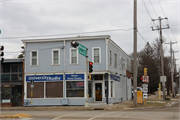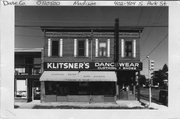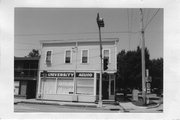Property Record
402-404 S PARK ST
Architecture and History Inventory
| Historic Name: | Cronin Brothers Saloon Building |
|---|---|
| Other Name: | University Audio |
| Contributing: | |
| Reference Number: | 110500 |
| Location (Address): | 402-404 S PARK ST |
|---|---|
| County: | Dane |
| City: | Madison |
| Township/Village: | |
| Unincorporated Community: | |
| Town: | |
| Range: | |
| Direction: | |
| Section: | |
| Quarter Section: | |
| Quarter/Quarter Section: |
| Year Built: | 1890 |
|---|---|
| Additions: | |
| Survey Date: | 20012025 |
| Historic Use: | tavern/bar |
| Architectural Style: | Italianate |
| Structural System: | Balloon Frame |
| Wall Material: | Aluminum/Vinyl Siding |
| Architect: | |
| Other Buildings On Site: | |
| Demolished?: | No |
| Demolished Date: |
| National/State Register Listing Name: | Not listed |
|---|---|
| National Register Listing Date: | |
| State Register Listing Date: |
| Additional Information: | Damaged by fire 2/20/1993. Frame const. oldest commercial building in Greenbush Addition. 2001: Integrity has been compromised by that addition of aluminum siding. Building housed the Moses Sweet Grocery for nearly 30 years between apprx. 1900 and 1930. According to the 1994 report, "Intensive Survey of Historic Resources of Madison", six grocery stores in Madison were operated by Russian Jews and served the Russian Jewish community. All were located in the Bush. Four are extant; 402-04 South Park St., 520 South Park St.(1922), 2 South Mills St (1922), and 402 West Lakeside St. (c. 1900). The most intact of these is 402 West Lakeside St., which was erected for Saul and Sarah Kasdin's grocery and housed their business for more than 30 years. Saul Kasdin was the second Jew from EAstern Europe to settle in Madison. He and his wife were prominent in Madison's Jewish community. In comparison with the Kasdin grocery, the Cronin Brothers' Saloon is not as intact. "In 1889 the Cronin Brothers (John and Matthew) removed their saloon from its longtime downtown home at 9 1/2 West Main Street to their new building located on the corner of Vilas Avenue and Park Street. This frame building is now the oldest commercial building in the Greenbush Addition. It is a fine and largely intact example of the Italianate vernacular style that was enormously popular for commercial buildings during this period. At first the Cronins ran a saloon on the first floor and Matthew Cronin lived int he apartment above. But three years later they sold the building to Peter Koltes, who divided the first floor and operated both a saloon and a grocery store. After Koltes retired, his grocery store was run by Moses Sweet, one of the first members of what would become one of Madison's largest Jewish families. Sweet's store served Madison's growing Jewish community, whose homes then lined Mound Street between Park and Murray Streets. The spiritual and social center of this community was the Agudas Achim Synagogue (built on the corner of Mound and Park Street in 1904). Eventually, larger synagogues were neeeded, culminating in the construction of the current Beth Israel Center at 1406 Mound Street. Almost all the original buildings associated with this community, including the first synagogue, were later demolished for the Triangle Redevelopment Project and expansion of Madison General Hospital." The Greenbush-Vilas Neighborhood: A Walking Tour. Madison Landmarks Commission and the Brittingham-Vilas Neighborhood Association, 1991. 2025; Two-story frame building; flat roof supported by corbel brackets; replacement door and glazed transom; replacement signage; replacement window at storefront. |
|---|---|
| Bibliographic References: | Tax records, city directory. The Greenbush-Vilas Neighborhood: A Walking Tour. Madison Landmarks Commission and the Brittingham-Vilas Neighborhood Association, 1991. Architecture/History Survey 2001: Elizabeth Miller |
| Wisconsin Architecture and History Inventory, State Historic Preservation Office, Wisconsin Historical Society, Madison, Wisconsin |



